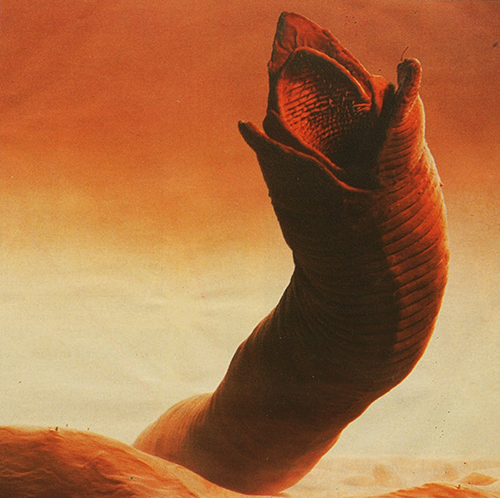Akestos
Surge Lord


Intent: Huge Breaching Worms and Troop Transport.
Image Credit: Dune 1984 Film | Custom Text
Canon: Rishi Eel
Links: [member="The Hive Mind"] | Akestos | [member="Kylraya"] | The Surge | SwarmSurge
GENERAL INFORMATION
Name: Surge Worm
Designation: Not-Sentient
Origins: The Hive Mind, also known as the Swarm Mind when speaking collectively.
Average Lifespan: 180
Estimated Population: Scattered
Description: Burrowing underground, to rip through the earth. The fearsome Surge Worm grows, and grows, and grows almost all its life. It is layered with lots of fat, muscle, and a very tough hide, in many layers around itself that grow outward, slowly shedding. Inside its mighty mouth, there is room to spare and quite often this worm itself is home to more than one Surge creature ready to burst out of it. There are two stomachs, one safe and cushioned for passengers, and one not safe at all for food. The Surge Impulse likes to smash through whatever is in the way with animals like this, then unload what waits inside on unsuspecting targets. Its mouth teeth can be avoided by most, how it feeds usually is to dive on a creature or more likely come up underneath it.

Breathes: Type IV Environments or Better
Average Height of Adults: 5 - 25 Meters | 16ft - 82ft | (Diameter)
Average Length of Adults: 50 - 500 Meters | 164ft - 1640 ft
Skin color: Orange, Red or Brown
Hair color: None
Distinctions: The sheer number of layers that wrap around the worm means that puncturing it without a weapon that is designed for piercing make it quite hardy, especially as it gets larger. Obviously shooting inside its mouth tends to have more luck, but even then most worms don't die easily. They can get squashed, torn, lose parts of themselves, and still move forward. While the worm can be and is often hatched after maybe two weeks at the smallest size, the longer it is grown in the hive's breeding chamber the larger it gets before it is born. As mentioned it has two distinct stomachs, one that is full of acid for digestion and one further forward that carries creatures into battle to unload, for example through a stone wall or armored structure. These carried creatures can get some food from inside the worm if it's available but it won't sustain them forever, realistically maybe a week or two tops. Probably the strongest part internally of the worm is around the creatures it carries, with extra internal layers of thick muscle keeping them safe. They do not breed naturally, this is a purely engineered species, the Rishi Eel enlarged. Because the worm grows throughout its life, it often gets too big, and becomes a problem rather than a bonus for the hive, which prefers to sustain a biosphere not destroy it in most cases.
Races: Surge Worm
Force Sensitivity: Non-Sensitive
Strengths:
- Troop Carrier. Between 30 and 250 man-sized creatures, depending on the worm size.
- Huge and keeps growing after being born.
- Powerful and burrows underground, able to feel surface vibrations above it for hunting.
- Can survive in most environments
- Tough. Lots of layers around the worm, make many weapons that only pierce a short way, like explosives, ineffective.
- Being a worm it can survive nasty injuries.
- More vulnerable inside the mouth
- You know when it is coming, you can hear and feel it a mile away.
- Continuous weapons, like particle or beam weapons, are effective against the worm. As are anti material rifles and railguns, or things designed to go a long way through something, rather than just explode around it.
- You couldn't miss it if you tried.
- These things take A LOT of food to satisfy. You won't find many about unless it is a very rich biosphere or they have little competition. Their growth becomes a problem for the Hive rather than a bonus past a certain point.
- Osmium is poisonous to them.
- If you are fast or small enough, you can avoid it head on.
- Doesn't breed on its own.
CULTURE
Diet: Omnivore, much-preferring meat. Feathers tend to irritate their stomachs.
Communication: Huge roars and subsonic shockwaves. They are very noisy, and so don't tend to communicate often. The Hive Mind and the Swarms Will also links their communication.
Technology level: None Existant.
Religion/Beliefs: The Surge Impulse is All. Expand.
General behavior: Eat and burrow tunnels, which the Hive uses to then populate with its structures or smaller creatures. The worms help shake up smaller food for other creatures to find, they also go after larger predators to remove them as competition from the food supply, especially if the Hive can not integrate those predators into itself. Finally, as the worms go between hive structures, they are able to connect hives underground, being very useful for establishing networks between Biospheres over long distances.
HISTORICAL INFORMATION
When the Hive first encountered the Rishi Eel it lost a lot of creatures into its maw. The galaxy has a lot of eel or worm creatures, more than you'd think as we don't often see them underground. At first, the Hive treated these large creatures as a threat whenever it found them. However realizing an ability to burrow could be useful, it applied this worm to some of the challenges it faced moving through harder earth or stone on some planets. The Eels did alright, but there wasn't enough power behind them, so they were enlarged. Having this creature burrow ahead of the Swarm has helped it enlarge its reach and set up networks of smaller hives connected together much more easily. Meaning the Hive's biospheres can be physically connected when this is of benefit.
For a time this simple use for the worms worked well. Until the Swarm came across a bigger underground predator, there is always a bigger predator. The worm burrowed into it and was then cut to pieces by the underground adversary. This was a setback because there was now a huge worm blocking the way! After spending time removing the giant creature, the Swarm's will decided that it was big enough to carry creatures inside of it. So if this encounter ever happened again, the creatures inside could deal with the threat, or at least slow the threat down, so the worm could make room for creatures behind it to come in. A second stomach was designed, over time this was refined to be more viable to those traveling inside of it. Comfortable is a stretch, safe would be a more accurate word.
There was a setback as there often is, a compromise. The worm's DNA alterations had a quirk, they kept growing. This sounds great, huge worm, wonderful, but it requires so much food as it ages it becomes a threat to sustaining the biosphere. The Hive has learned to adapt, and uses the worms till they are a certain size, then recycles the biomass it collects along its lifetime, refining it for this purpose. There are a few worlds that support large lifeforms naturally, or just offer more food, and so there are a few worms that it keeps large as a result.
https://www.youtube.com/watch?v=P50b-19_j8c



